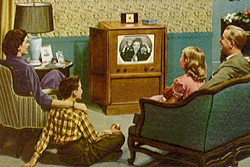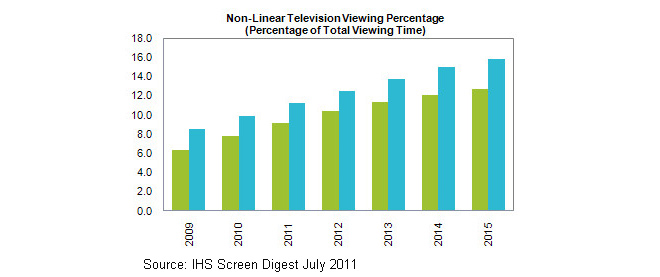Europe's online source of news, data & analysis for professionals involved in packaged media and new delivery technologies

Rise of non-linear TV not about to threaten traditional broadcasters
Despite the growth of on-demand video and recording technologies such as the digital video recorder (DVR), the vast bulk of consumer television viewing time is still expected to be devoted to real-time, linear programming through the year 2015, according to the IHS Screen Digest TV Intelligence Service.
DVR, on-demand and other forms of non-linear programming will account for only 15.8% of television viewing in the United States in 2015, up from 9.9% in 2010, with the remainder made up by traditional linear TV watching. In the United Kingdom, non-linear will account for 12.7% of television viewing in 2015, up from 7.8% in 2010, as presented in the figure below.

Non-linear television is defined as non-traditional means of viewing that enables place- and time-shifting. This contrasts with traditional linear television, where viewers must watch a scheduled TV programme at the time it is broadcast, and on the channel it is presented on.
Other countries are expected to have even lower rates of non-linear television viewing, including France, Germany, Italy and Spain.
The rate of non-linear television viewing via on-demand services is actually trailing the usage of DVRs, which have entered the mainstream in the most developed markets. Already rolled out to one-third of US television homes, DVRs by the end of 2015 will have penetrated almost half of all American households.
In contrast, on-demand services still suffer from a number of issues that have led to their underuse compared to DVRs, according to HIS. Content fragmentation and restrictions across different portals and services mean that for most consumers, on-demand services offer much less variety in content than an array of linear channels from a cable or satellite operator. This will be an important constraining factor in the future and as more households gain access to video on-demand services, one of the main limitations on consumer usage of on-demand.
HIS adds that a further reason for the limited penetration of non-linear TV viewing is that television broadcasters are taking steps that will help to retain viewers of traditional linear broadcasting by offering more high-definition content.
“Linear TV has not stood still as non-linear distribution mechanisms have developed,” said RichardBroughton, senior analyst, television, for IHS. “Alongside the evolution of Internet video and DVR technology, broadcasters have introduced HD channels, now received by more than 40% of US households. In contrast, the Internet in many markets still struggles to cope with HD content and the high bandwidths required for its delivery. Streaming HD remains relatively rare, and downloading takes time, diminishing the appeal for consumers.”
Story filed 03.08.11



















